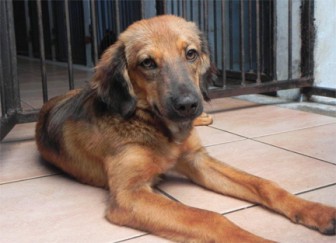Following on from last week’s topic on torn knee ligaments, let us now focus on the symptoms.
The signs that indicate that something is wrong at the knee would, first and foremost, be lameness, pain, swelling around the joint, fluid accumulation in and around the knee joint, a crackling/grating (sometimes clicking) sound is heard/felt as the joint is manipulated. An X-ray picture would help, especially in the case of long standing injuries. Some vets might want (via needle and syringe) to extract some fluid for microscopic examination which could reveal mild cellular increases and even the presence of blood. Arthroscopy (looking into the joint) can confirm the diagnosis, but this requires the use of specialized equipment.
Treatment

 The long-term therapy would include both medical and surgical interventions. Weight reduction, controlled physical activity and non-steroid anti-inflammatory drugs (eg aspirin, Phenylbutazone, etc) could be brought into the treatment arsenal.
The long-term therapy would include both medical and surgical interventions. Weight reduction, controlled physical activity and non-steroid anti-inflammatory drugs (eg aspirin, Phenylbutazone, etc) could be brought into the treatment arsenal.
The pain killers and the anti-inflammatory drugs ease the pain and discomfort caused by the inflammation and the degenerative joint disease. In the end, however, surgical stabilization of the joint (especially in active dogs) is the way to go. The prognosis after surgery is pretty good, as long as the degeneration in the joints hasn’t gone too far.
Some specific joint problems based on other origins
Genetic disorders
Many of the bone problems of our pets stem from the fact that, much too often, the puppies or the kittens which we take into our homes actually are the offspring of parents who are themselves related.
For some time now, for example, very little fresh blood (new genetic stock) has been imported into the country for breeding purposes. In fact, the number of ‘breeders,’ who would even consider importing proven sires or females (and who have actually done so) could be counted on one hand. This means that many of the Doberman, German Shepherd/Rottweiler (the popular pure breeds) puppies/adult dogs you see, may, in fact, be related – some more closely than others.
During any vet’s practice, one encounters puppies/kittens that exhibit deformed jaws, hernias, twisted legs, monorchidism (only one testicle), or no descended testicles, etc). Often, these maladies are the result of incest. Now imagine that if there are physical deformities which you can see, how many more are present within the animal’s body and which are not visible.
Sometimes these products of incest have holes in their hearts, underdeveloped kidneys and ovaries, deficiencies in the immune system etc – all profound ailments which cannot be seen when you collect your puppy. In fact, some of these deficiencies do not show themselves until the animal is much older. A classic example is hip joint dysplasia.
Hip joint dysplasia (HJD)
As the name suggests, this is a problem that has its focus at the joint where the thigh bone (femur) meets with the hip bone (pelvis). There was a time in my life (as a young doctor in the Clinic and Polyclinic for Small Animals in Leipzig, Germany) when this ailment was so prevalent, I thought that all hind leg lamenesses were due to HJD. Here in Guyana, although this ailment is relatively common, mechanical traumas (vehicle accidents, hits from the humans, etc) are the most common cause for limping.
HJD is found mostly in large dogs (any breed over 35 pounds), like German Shepherds, Rottweilers, St Bernards, etc. There is much abnormal development at the hip/thigh joint, and this is characterized by a looseness (not firm and rigid) and subsequent degeneration of the joint. Several factors play a role in this ailment.
Excessive growth of heavy dogs (eg St Bernard), too much exercise, faulty nutrition, and above all, a hereditary predisposition are all factors which influence the development of this disease. When all is said and done, the actual problem stems from the fact that there is a disparity between the hip joint muscle mass and rapid bone development.
Consequently, joint instability develops, and this brings anatomical changes in the joint. Some of these changes could be: (i) the flattening out (getting shallow) of the cup (socket) of the hip bone into which the head (ball) of the thigh bone fits, (ii) a hardening of the tissue around the joint, (iii) a thickening of the head/neck of the thigh bone, which fits into the socket (acetabulum) of the hip bone.
All of the above changes can lead to the thigh slipping out of the hip socket (luxation).
Next week, we’ll discuss the clinical signs and the treatment of HJD.





